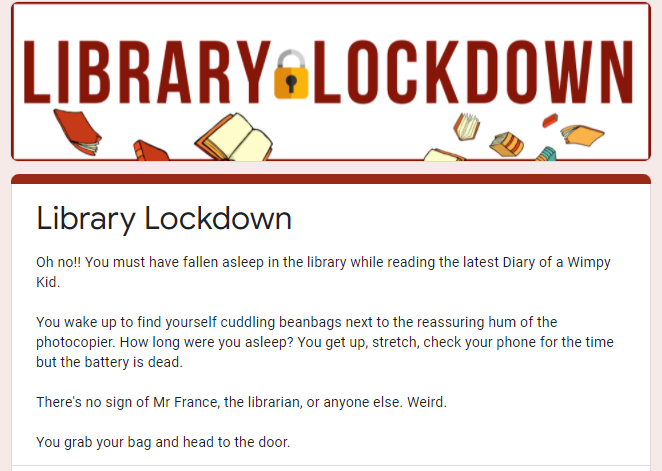Digital Escape Room – Preston Lodge High School, Prestonpans
Category: #LibrariesAreEssential - Scotland's Stories, Branches and Groups, SLG Scotland
SLG Scotland regularly showcase an activity or project that furthers one of the strategic aims of Vibrant Libraries, Thriving Schools (VLTS): A National Strategy for School Libraries 2018 – 2023. Here, School Librarian Derek France tells us more about how he created digital escape rooms as a P7 transition activity during lockdown.
Name
Derek France
School
Preston Lodge High School, Prestonpans
Title
Digital Escape Rooms
Furthering Strategic Aim:
2: Information, Digital Literacy and Digital Creativity
The Initiative
When the first lockdown was announced back in 2020, I didn’t want to lose contact with pupils and wondered how to keep them engaged. I thought a degree of continuity would benefit pupils so I created online versions of the library clubs using Google Meet: book clubs, creative writing clubs, Dungeons & Dragons, and Manga Club. We met weekdays at lunchtime, like we did in school. This worked well and I was pleased with pupil engagement, but I was concerned about the upcoming P7 transition. The P7 library inductions are usually great fun and I always strive to make it a memorable experience for pupils. This would be a virtual transition. I’d heard of digital escape rooms (solving puzzles to complete an adventure) and wondered about designing a library-themed escape room incorporating all the basics of induction.
I researched A LOT of digital escape rooms (all resources on my Wakelet) and discovered a fabulous resources called Twine, ‘an open-source tool for telling interactive, non-linear stories’. Unfortunately, it does not provide analytics for usage data, but I’m sure I’ll come back to this for personal and professional use. I found Google Forms to be the most popular, mainly due to its simplicity (perfect!) and a Harry Potter themed escape room which went viral and influenced a multitude of librarians to design their own. This 15-minute video explains how to create a digital escape room using Google Forms, which was ideal, as our school uses Google for Education. Google Forms offers an option requiring pupils to sign-in before starting the escape room, restricting access to users who have an edubuzz.org account. This would have given personalised usage data of pupils, but I decided not to use that as many of the P7s would not have an email address, and this offered user anonymity while allowing me to gather general usage statistics. I was delighted to receive 67 responses.
The concept behind my escape room was quite simple: a pupil wakes up in the library and finds themselves locked in. To escape, they need to work through a series of puzzles based upon my library induction, with a little help from my (imaginary) grump, cloven-hooved library assistant: shelving, library sections, the digital library, and some fake news. My Pupil Librarians did a ‘test run’ on the final draft and recommended adding a video question. Can you escape the library?
Impact
The Senior Leadership Team were enthusiastic and included it as part of the main P7 virtual induction. I shared it on the school website and newsletter, and the library’s Twitter and Instagram accounts. It caught the attention of staff from our primary cluster, asking to share it with younger pupils, and I was happy for them to do so.
I repeated this during the 2021 restrictions, this time meeting the P7 classes on Google Meet. It was good to see their reactions while working through the questions. When I finally met the P7s in person (now S1), feedback suggested they really enjoyed it. In fact, they asked for more! I foresee a physical escape room for this year’s P7 transition…


